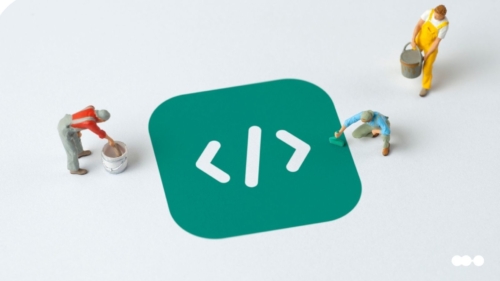
Industries with a great need for automation include manufacturing, information technology (IT) and transportation. Advancements in intelligent automation have been particularly rapid during the last decade, including robotic process automation (RPA) and intelligent process automation (IPA).
These technologies are closely related, but they have distinct differences. This guide explores their differences, in addition to their benefits, features, and limitations.
Choose the right automation solution with the Buyer’s Guide to Automation Platforms
What is robotic process automation (RPA)?
RPA is any technology that imitates human actions based on a set of rules. RPA deploys software robotics, or bots, to mimic manual or repetitive tasks. The most suitable tasks for RPA are time-consuming and repetitive, including copying data, logging into programs, and connecting to APIs. It uses specialized software known as bots to automate these tasks, which humans have previously performed directly.
This has emerged as a breakthrough technology since the late 20th century, gaining wide acceptance in greatly altering business operations. Organizations use RPA to accelerate and optimize their processes, generally by structuring inputs to standardize operations.
Key features and benefits
Key features of RPA include bots that complete tasks more quickly and accurately than humans, often around the clock. It also offers increased scalability, greater operational precision, and enhanced regulatory compliance, resulting in significant cost savings. RPA thus allows human workers to focus on high-value jobs requiring creativity, while RPA performs low-level tasks.
For example, manual onboarding requires administrators to enter and move data between systems when the organization hires a new employee. RPA can perform much of this work automatically, helping to eliminate the need to input data more than once. HR managers also benefit from RPA, which can generate offer letters in accordance with established procedures without requiring much direct action from them.
Additional benefits of RPA include reducing human error, which becomes more expensive to correct the longer they remain undetected. This type of automation also allows organizations to gather data from multiple sources and consolidate it into a centralized location.
Examples of industries benefiting from RPA
Industries gaining the greatest benefits from RPA include finance, HR, and retail.
Finance
Financial departments perform many tedious tasks that are prone to human error, making RPA an excellent choice for this area. For example, companies can receive invoices in many ways, which they must match to the correct purchase orders (POs) before approving them for payment.
RPA solutions can automatically fill out and send most invoices, so employees can work on outliers that don’t follow the rules. The automated procedure for matching invoices to POs can include marking these special cases for further review by a human.
HR
Hiring a single worker can require weeks with manual processes, follow-ups, and coordination, but RPA can reduce this time by automatically performing many of these rules-based tasks.
For example, bots can continuously search job boards for new candidates, and they may also be able to screen their resumes for specific criteria. In addition, bots can submit applications to multiple departments without requiring extra work from employees.
Procurement and supply chain management
Labor-intensive tasks in procurement or supply chain management that lend themselves to automation, especially for companies that must track a high volume of requests or orders.
By automating tasks like low-inventory alerts and even ordering, inventory management, and procurement become much more predictable and efficient, which is particularly beneficial for the many businesses with a high rate of errors in their inventory or fulfillment records. This creates better experiences for all stakeholders — procurement, requesters, suppliers, and customers.
What is intelligent process automation (IPA)?
Intelligent Process Automation (IPA) is the development and implementation of process automation, while RPA executes it. In other words, the evolution of RPA into IPA is characterized by technologies like artificial intelligence (AI), machine learning (ML) and natural language processing (NLP), which optimize entire processes rather than individual tasks as RPA does.
Examples of IPA include RPA, as well as other techniques such as business process automation (BPA) and cognitive automation, all of which may use AI and ML. These forms of IPA help streamline processes, allowing users to focus on the end result rather than the individual processes or applications needed to achieve it.
Key features and benefits
RPA can automate functions in both the front and back offices by itself, but the use of IPA platforms allows automation to go much further. IPA can analyze data for the application of cognitive technologies, even if that data isn’t structured. Users are then able to develop efficient workflows based on these insights, especially in customer service applications like chatbots.
This approach to automation involves users developing new processes rather than simply automating existing tasks, generally by incorporating intelligent technologies like AI and ML.
Furthermore, IPA platforms examine data in real time to optimize operations such as routing workflows. For example, they can change workflows based on expected flow control, log content, and run times.
Examples of industries benefiting from IPA
The use of IPA to power chatbots on websites is becoming increasingly common in business. Finance departments are also using it to perform analytics such as tax forecasting. Additional use cases for IPA include manufacturing and healthcare.
Financial services
The strong need to reduce process completion times in finance makes this area a prime candidate for IPA. Financial documents like claims, credit, and loan applications are still in paper form in many cases, which IPA can greatly accelerate through the use of predefined standards.
As a result, workers have faster access to the information they need to serve customers fast and accurately.
Manufacturing
The primary benefits of IPA in manufacturing include improvements in product quality and operational efficiency. Automating the administration of supply chains means that a single digital location stores all of the paperwork, reducing manual input and its consequent risk of human error.
IPA also enables the implementation of a smart factory, in which all production tasks are integrated into a single process, allowing manufacturers to respond more quickly to changes in customer requirements.
Healthcare
Healthcare workers routinely enter data through multiple applications, often the same data. These procedures take time away from patient care, which should be their primary focus. IPA eliminates the need to manually transfer data between applications, thus reducing the need for duplicate data entry.
Key differences between RPA and IPA
The close relationship between RPA and IPA can make it difficult to distinguish between them. The following table summarizes their key differences. (The comparisons are easier to understand when you think of IPA as the brains of automation and RPA as the muscle.)
| Robotic Process Automation | Intelligent Process Automation | |
| Processes | RPA imitates the way employees perform processes. | An integrated method of automating processes that change regularly, requiring a human to make choices. |
| Data type | Workers require training to complete processes in a way that depends on structured data. | Processes are data driven and use intelligent techniques to process unstructured data. |
| Time improvement | Processes don’t improve over time. | Self-learning, so it improves processes over the long term. |
| Scaling | Difficult to scale. | Easier to scale, since it handles unstructured data. |
RPA vs. IPA: Which one is better?
RPA
If you’re interested in a solution to solve simple repetitive and manual tasks that require minimal variation in execution, then RPA may be ideal.
RPA uses bots to automate processes, which is best for performing simple, repetitive tasks. Bots work quickly and efficiently, so they can easily reduce the time needed to complete tasks without human intervention.
However, it’s more difficult to implement due to the need to specify each step, which can make it less suitable for large applications.
IPA
If you’re interested in an agile or flexible solution to solve more complex tasks or end-to-end processes and have the resources to scale and manage changing needs for large applications, then IPA may be the best choice.
IPA uses intelligent technologies to automate processes, which can be more effective in automating complex tasks. It’s also able to identify process inefficiencies that RPA can’t.
However, IPA is also more expensive to maintain than RPA, especially when processes frequently change.
Easily automate your processes with Pipefy
With Pipefy’s no-code business process automation (BPA) platform, scaling automated workflows and processes is easy. Our no-code user interface encourages teams and process owners to be autonomous and take ownership of continuous process improvement, enabling more agile and creative partnerships with IT.
Elevate Pipefy’s process automation capabilities with ABBYY’s optical character recognition (OCR) technology. Through the integration of solutions like Pipefy and ABBYY, facilitate document-based process automation and accelerate digital transformation initiatives.







